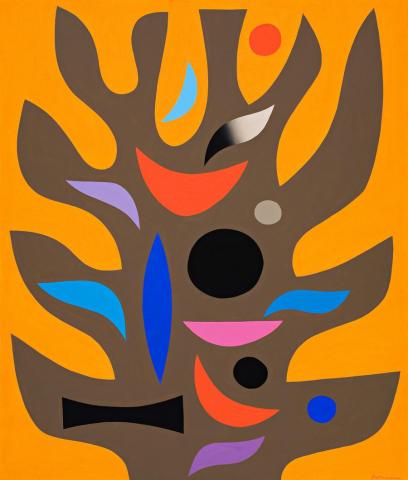RESURRECTION TREE, 1973
John Coburn
synthetic polymer paint on canvas
202.5 x 171.5 cm
signed lower right: Coburn
inscribed verso: RESURRECTION TREE / JOHN COBURN / SYDNEY 1973
Private collection, Melbourne
Deutscher~Menzies, Melbourne, 26 November 2003, lot 42
Private company collection, Sydney
Amadio, N., John Coburn Paintings, Craftsman House, Sydney, 1988, p. 198
Ideas and motifs central to John Coburn's art abound in Resurrection Tree. The tree itself is a favourite, a symbol sacred from ancient times, both pagan and Christian. The Druids had their sacred oaks, the Tree of Knowledge grew in the Garden of Eden, and there is the wood of the Cross through which salvation came into the world. The Cross, in turn, led to the Resurrection and eternal life. Crucifixions appear early in Coburn's art - his painting, The Passion, 1960, being awarded the prestigious Blake Prize for Religious Art in the same year. A few years later, the tree image found its chief expression in Coburn's Tree of Life paintings, beginning in 1965 with Tree of Life I in the collection of the Art Gallery of New South Wales. Two later versions were painted in 1973, Tree of Life III being in the Vatican Museum Collection of Modern Religious Art.
In these and other paintings Coburn confirmed himself as one of Australia's foremost religious artists, feelings of joy and hope permeating his work. His art is deeply rooted in nature, twin primary influences being the tropical fecundity of his mother's garden in north Queensland and the hot, dry deserts of the outback. Each inspired paintings and tapestries in which either the cool colours of blues and greens or hot reds and browns predominate - as in Primordial Garden, 1965-66, in the National Gallery of Victoria and Dark Descent, 1966, in the Newcastle Region Art Gallery. In 1970, they reached a brilliant climax in Coburn's two tapestry curtains for the Sydney Opera House - Curtain of the Moon and Curtain of the Sun.
A master of hard-edge and colour-field painting, Coburn used powerfully reductive imagery and pulsating colours in harmony. In geometric and biomorphic forms reduced to their seemingly most simplistic, he explored and expressed complex ideas of life and regeneration.
In Resurrection Tree, the mood is one of celebration expressed equally through the colours and the up-reaching shapes of tree trunk and branches - flame-like forms of life. They also speak of hands raised in praise and mouths wide open in song, of sonorous colours joined in festive moment.
DAVID THOMAS
